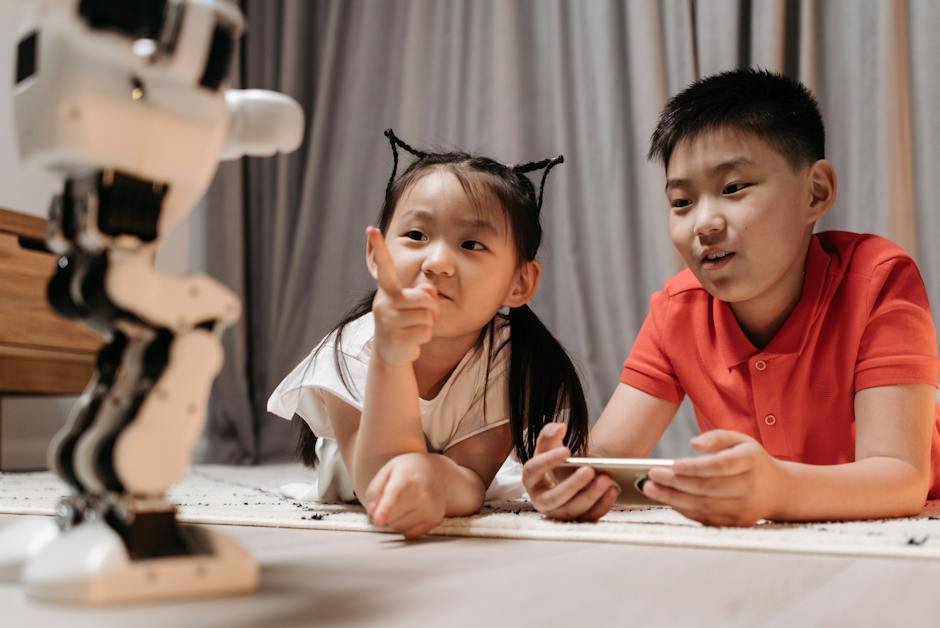
Autism, a complex neurological disorder, is surrounded by an array of misconceptions and mysteries, often making it challenging for the layman to comprehend. Far more than just a clinical diagnosis, it encompasses a wide spectrum of behaviors and developmental idiosyncrasies, presenting unique struggles and strengths for each individual. This essay aims to dissect the intricacies of autism and delve deep into the promising realm of artificial intelligence (AI), elucidating how this cutting-edge technology can support children with autism. By intertwining detailed case studies with forward-looking projections for 2023, the piece transcends the present by contemplating the future applications of AI in the world of autism.
Understanding Autism
Understanding Autism in Our Children: What to Know, How to Support
The journey of parenting comes with the sweetness and delight of watching our children grow, and also, the challenges and unexpected turns that often leave us perplexed. One such unexpected turn many of us face is navigating the world of Autism Spectrum Disorder (ASD). Whether it’s because of a personal parenting experience, or it’s simply about being more informed, understanding Autism is something of significance for every one of us in the parenting community.
Autism, often referred to as Autism Spectrum Disorder, is a neurodevelopmental condition usually marked by social interaction difficulties, communication challenges, and a pattern of repetitive behavior. To set the record straight from the get-go, it’s essential to point out that Autism is not a disease, but a unique way a person’s brain is wired. Of course, this means that children with Autism have their own exceptional ways of understanding, interacting with, and responding to the world.
When it comes to identifying Autism in children, it’s more about recognizing differences rather than fitting into a specific mold. Here are few common signs parents and caregivers might notice:
- Social Challenges: Children with autism may appear to be uninterested in social interactions or find it challenging to underpin social cues. They might not respond to their name by the age of 12 months, resist cuddling or holding, or prefer playing alone.
- Communication Difficulties: They may have delayed speech development which includes a slow rate in learning to talk, ebb and flow in the ability to carry a conversation, and repetition of phrases.
- Repetitive Behaviors: They can also show repetitive motions like flapping hands, rocking back and forth, or turning in circles, have specific rituals, or express distress at minor changes in routine.
But at the heart of it all, it’s imperative to remember that every child is unique. No two children with Autism are the same, just like no two neurotypical children are the same. The diagnosis and understanding of Autism can be a complex process that requires the knowledge and assessment of skilled professionals.
After an autism diagnosis, it’s natural to feel overwhelmed, distressed, or even helpless. But rest assured, support is available and advancements have been made in care and therapy for autistic children. Early intervention with effective therapies and various coping mechanisms can improve the life quality of the child and assist them in developing meaningful relationships and living fulfilling lives.
Most importantly, accepting and celebrating our children for who they are is a fundamental part of being a parent. Children with autism are often described as living in their own world. Well, it’s up to us to enter, understand, and cherish their world. Remember, Love, patience, and understanding are the most crucial tools in our parenting kit.
As we embrace this journey together, let’s remember to treat our children with autism with the same love, support, and encouragement we give to all our children. Let’s strive together towards an informed, compassionate, and inclusive community. Mark Twain once said, “The two most important days in your life are the day you are born, and the day you find out why.” The why? It could be as simple as making the world a better place, one act of understanding and love at a time.

How Artificial Intelligence benefits children with Autism
Introduction: In the Advanced Age of AI
Entering a world where technology isn’t just a luxury but a necessity, it’s essential to explore all the possibilities it brings. Technological advancements, especially AI, are transforming numerous sectors, including mental health and education. Among these developments, we find a novel avenue of hope for managing and teaching those precious children who are part of the Autism Spectrum Disorder.
AI and Autism: A New Dawn of Opportunities
Artificial Intelligence (AI) isn’t something out of a sci-fi movie anymore – it’s present in our everyday lives. Whether it’s Siri on your iPhone, Alexa in your kitchen, or a recommendation algorithm on Netflix, you’re already engaging with AI. Now, imagine this powerful tool being employed for the betterment of lives—specifically those with Autism.
AI is creating a revolution in how we address Autism. By augmenting traditional therapies with AI-powered tools, new possibilities are opening up to improve communication, social interaction, and behavioral patterns among children with Autism.
The Robot Comps: Facilitating Social Interaction
One of the most ground-breaking implementations of AI in Autism intervention is the use of robots. These aren’t your typical R2D2s; they are highly sophisticated pieces of machinery trained to interact with children with Autism. With their consistent behavior, unique appearance, and capacity for repetition, robots can make social interactions less overwhelming for children on the spectrum. They deliver therapy instructions, narrate social stories, and teach mimicry, significantly enhancing children’s ability to communicate and socialize.
Augmentative & Alternative Communication (AAC) Devices: The Game Changers
AAC devices equipped with AI technology are proving to be monumental in helping non-verbal or minimally verbal individuals express themselves. Through customizable options, these devices can mirror an individual’s communication needs, no matter how niche or person-specific they may be. For instance, an AAC application can learn a child’s routine and offer context-appropriate communication suggestions.
AI-Based Learning Platforms: Personalized Education
With the power of AI in online learning platforms, personalized education can be provided to every child with Autism. These AI-driven platforms can adapt to the learning pace and style of each child, easily accommodating their individual needs. By providing interactive and engaging content, these platforms stimulate learning, turning it into a fun process rather than a monotonous routine.
Empowering Parents & Educators with Data Analytics
Finally, the integration of AI and data analysis empowers parents and educators with valuable insights into a child’s behavior trends and learning progress. AI can help identify patterns and predict future behaviors, helping caregivers adapt strategies effectively.
In conclusion, AI is no magic wand; however, packed with immense potential, it is undoubtedly a promising ally in managing and teaching children with Autism. It provides a wealth of avenues to make life better for those on the spectrum and their families, ushering in an era of more inclusive and efficient approaches to Autism. Embracing these new possibilities, we can weave a world where no child feels isolated or misunderstood, but celebrated and cherished for their unique lives.

AI applications in Autism Intervention – Case Studies
therapy
In this ever-advancing world inundated with groundbreaking technology, AI, aka artificial intelligence, continues to revolutionize almost every sector of life. For families raising children with Autism, these technological strides have been a beacon of hope, making strides in enhancing the lives of these special kids.
Perhaps one of the most delightful success stories is the creation and implementation of AI bots, essentially friendly robots that incorporate AI to help children with Autism learn and socialize. Take “Milo,” for instance, a robot specifically designed to aid children with Autism. With his inviting, human-like interface, Milo helps teach social skills by demonstrating facial expressions, verbal conversation styles, and empathy. The beauty lies in the fact that Milo never grows impatient or frustrated. This consistency allows children to learn at their own comfort and pace, promoting an environment of positive reinforcement.
Moving away from humanoid robots, AI has also significantly influenced the realm of Augmentative and Alternative Communication (AAC). These AAC devices, equipped with AI tech, have proven incredibly beneficial for children with Autism who face difficulties in communication. For instance, the popular app, “Proloquo2Go,” uses AI to convert pictures into speech, making it easier for a child to communicate their thoughts and needs. Particularly for children who are non-verbal, such apps can be life-changing.
AI-based learning platforms, such as “Otsimo,” are also making waves in the realm of Autism intervention. These platforms leverage AI to present personalized learning content tailored to each child’s unique needs and abilities. Through engaging games and activities, these platforms provide learning opportunities across areas such as language skills, cognitive development, and emotional awareness, all while making learning fun.
The integration of AI in educational tools doesn’t only aid the children, but also the parents and educators. With AI’s uncanny ability to analyze vast amounts of data, it can discern patterns and provide insights into a child’s behavior. This proactive approach helps caregivers and educators devise more effective strategies tailored to that specific child’s needs, facilitating their development optimally.
The journey of nurturing a child with Autism can be both challenging and rewarding. In every step of the journey, what matters most is the unconditional love, patience, and understanding we demonstrate. While it’s commendable how far we’ve come in terms of providing the right tools and resources to children with Autism, the possibilities yet to come are equally exciting. AI stands as a shining testament to the future’s potential, creating a more inclusive world where every child, irrespective of their abilities or challenges, can shine in their unique light. Technology has helped and continues to go the extra mile to bring that vision to reality.

The Future of AI in Autism – Trends and Predictions for 2023
Looking forward, the year 2023 shows immense promise for the convergence of Artificial Intelligence (AI) with autism education and therapy. As the wave of technological advancements continues to shape various sectors, the intersection of AI with Autism Spectrum Disorder is no exception.
Imagine AI-driven platforms designed to aid children with autism in enhancing their social skills. Sure, robots and AI bots sound like they belong more in a science fiction movie rather than in a child’s therapy session. However, these bots, designed with interactive features, can engage autistic children in simple, yet significant social scenarios. These bots could simulate situations such as initiating greetings, interpreting facial expressions, maintaining eye contact, or navigating a conversation. All steps through which AI can actively play a part in enhancing these critical skills in children with autism.
Switching gears to another groundbreaking aspect – Augmentive and Alternative Communication (AAC) devices. These tools are powered by AI and can give a voice to children with communication difficulties. These incredible designs can translate gestures, eye movements, or even brainwaves into speech or written words. Hence, reducing the frustration many autistic children feel due to their inability to communicate effectively.
Education is another sector where AI could work wonders. With AI-based learning platforms, education is becoming more personalized than ever before. These platforms enable educators to tailor their teaching styles to each child’s unique learning needs. By using machine learning algorithms, these platforms can analyze a child’s learning pattern, pinpoint areas of difficulty, and adapt coursework accordingly. This bespoke learning approach could help children with autism thrive in their educational journey.
Furthermore, AI is not just offering solutions for children with autism but also providing valuable insights for caregivers and educators. AI’s data analytics capabilities can analyze behavioral data and provide critical insights. These could range from detecting early warning signs of a meltdown to identifying specific triggers and dealing with them preemptively.
Love, patience, and understanding will always be at the core of nurturing a child with Autism. However, a tool like AI that can further enhance a child’s abilities and offer personalized attention is a valuable ally in this journey.
In conclusion, while it is impossible to predict exactly how technology will continue to evolve, one thing is clear: the potential for AI in autism education and therapy is immense. Embracing AI’s capabilities could indeed pave the way for a more inclusive, understanding world for children with Autism Spectrum Disorder. AI’s ever-advancing technology might just have the potential to fuel a revolution in the world of autism education and therapy, bringing it leaps and bounds into the future.

As we stride into 2023, we stand at an extraordinary juncture where technology and humanity converge, fostering greater advances in supporting those with autism. AI’s transformative potential promises a future where individual requirements of autistic children can be met with precision and understanding, enhancing their quality of life significantly. The leaps and bounds made by AI in autism intervention are examples of how technology serves as a catalyst for unlocking human potential. Undoubtedly, as this frontier expands further, we can envision a future where AI-driven interventions seamlessly intertwine with the conventional methodologies, empowering each child on the spectrum to reach their utmost potential.




